Monday July 18, 2011
High speed train will move economy
IT is time that the Government revived the High Speed Rail (HSR) service proposal to connect Kuala Lumpur and Singapore. In fact an HSR service should link Singapore and Butterworth in Penang.
All over the world countries see HSR services as the best mass transportation option between cities. China and South Korea are the leaders in the construction of HSR service networks for their people. China holds the record for the longest HSR network in the world.
On July 1, China launched an HSR service between Beijing and Shanghai. The train can reach a maximum speed of 300 km/hr, and travelling time between the two big cities – 1,318km apart – is less than five hours.
However, in Malaysia we are still debating whether or not to carry out such a project. Many views were put forward by the critics of this project, who see it as wasteful, and by transportation players, who look at it from their business point of view.
In time, the highways will not be able to cope with the number of vehicles on the road. More highways will need to be built. But this is not the best solution.
I think an HSR project will benefit Malaysia more than Singapore if we can align the route to take in the denser populated towns in Malacca and Johor.
The route from Kuala Lumpur to Singapore should pass through Seremban, Simpang Empat, Air Keroh, Muar, Batu Pahat, and Iskandar.
This will not affect the KTMB double tracking project as people in Seremban, Tampin, Segamat, Gemas, Yong Peng, Kluang and Kulai will still need reliable and safe inter city transportation.
By passing through Air Keroh, Muar, Batu Pahat and Iskandar these towns will benefit in terms of tourism and property values. Singaporeans will start to buy landed properties in these towns for investment or as their second home.
The northern towns stretching from Air Keroh to Penang will benefit from tourism, as travelling by HSR is more reliable and safer. There are many places in Johor, Malacca, Negri Sembilan, Selangor, Perak and Penang that can be promoted for tourism.
Also, there will be no need for Singaporeans to then drive into Malaysia.
In the next five to ten years, the Government will see a significant increase in GNI (Gross National Income), and the construction activities will add to Gross Domestic Product initially, as well as GNI in the latter years, from tourism and property transactions.
Coastal towns in Johor and Malacca will reap the benefits as weekend tourists spur business activities there. In this way, the Government will spread the economic cake to many parts of the country and achieve the high income target for many homes by 2020.
Therefore, the Government should re-look the proposal on this project and take in KTMB as a partner.
A decision has to be made quickly for the benefit of all Malaysians.
ESA ADAM,
Subang Jaya.

No comments:
Post a Comment